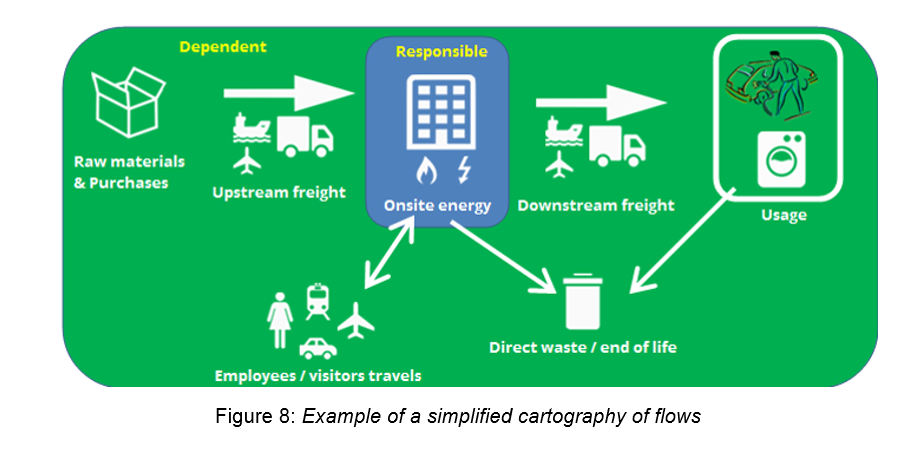ΠΩΣ ΝΑ ΧΡΗΣΙΜΟΠΟΙΗΣΕΤΕ ΤΟ ΕΡΓΑΛΕΙΟ
Defining the perimeter
The definition of the perimeter is a highly important step for any carbon footprint project, if not the most important. At least it is one of the very first question to ask yourself at the beginning of the project.
Direct (on site) and indirect (upstream and downstream) emissions should be equally considered. The aim of the calculation is not to obtain the lower result of the carbon footprint but to have an idea of which parts of the organisation activity are the most emitting ones. It is not recommended to restrict the calculation to the emissions produced on site (scope 1 & 2) and to exclude emissions too hard to collect or those generating a double counting (see below).
Keep in mind that the tool only builds a picture of the emissions at a given moment (described below as “a given period”)!
To define the perimeter in practical manner, it is required to build the cartography of energetic and materials flows that are related and needed by the organization during a given period (usually 1 year).
All flows should be considered: not only the flow the organization is officially responsible for but also flows the organization is dependent on (upstream/downstream). To determine if one flow is important for the calculation, ask yourself “Would the activity be unchanged if one of the flow doesn’t exist?”
In order to consider the impact of you activity correctly, you should extend your calculation to indirect emissions (upstream and downstream). In this way, you establish a complete vision of your activity and the emissions it generates. You can identify the key points on which you should act to reduce efficiently the emissions.
The perimeter definition helps to have a clear view of the objective of the study, including the level of detail, which will impact the time and resources needed to perform the work. With a wide perimeter and number of emission sources, we can identify a large number of potential risks and opportunities, and therefore, a large number of possible actions of reduction.
What data do I need ?
Collecting activity data is a key step for a GHG accounting as it gives material to use the Bilan Carbone© Clim’Foot tool. When defining the perimeter, you should be aware of the quantity of data you will have to gather. To succeed, it is necessary that you identify:
-
availability of data,
-
missing emission factors,
-
activity data owners.
Assessing CFO is a very transversal analysis and getting support from the top management of the organization and from all employees makes data collection faster and easier. For estimating indirect emissions, you will need internal and external resources. Additional research in statistics, web, books and other sources could complete or clarify data. To begin with, focus on the main emission sources and use an iterative approach with uncertainty percentage to make best allocation of resources.
To avoid a loss of data, store all data collected in a specific sheet for processing and documentation (cf IFC shopping list, downloadable here).
To see the answer of the quizz, just move the mouse over the picture!
See the next page "What to do with the results". Or return to the menu.


